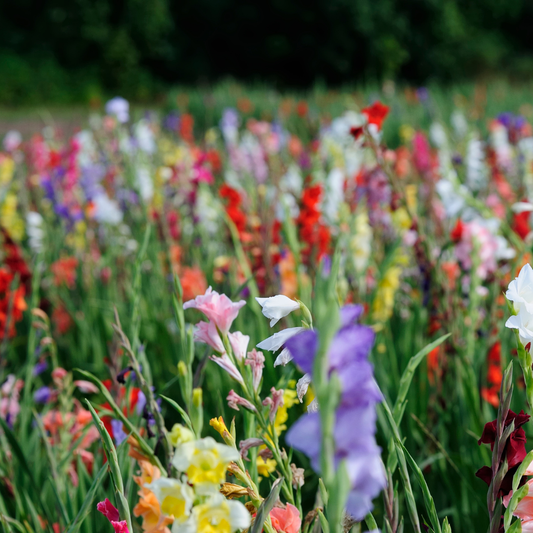
When to Plant Hostas?
Share
When to plant hostas: the guide to the ideal timing
What is a hosta and why is timing important?
The hosta, also known as plantain lily, is a popular perennial plant prized primarily for its beautiful foliage. This shade-loving plant adds a colorful touch to your garden thanks to its variety of colors and leaf patterns. But as with many plants, choosing the right time to plant your hosta is essential for a good start and healthy growth.The right season and the right conditions can make the difference between a languishing plant and a vibrant green eye-catcher. This guide will show you step-by-step when it's best to plant a hosta, both in the ground and in a greenhouse. This will give your plant a flying start and avoid frustration.
Best time to plant hostas in open ground
The ideal time to plant your hosta in the ground is spring, from late March to late May. The soil is then workable, no longer frozen, and the plant has plenty of time to establish roots before the summer heat hits. Wait for a cloudy, preferably slightly rainy day – strong sun or dry spells can dry out young plants.A second option is autumn, from September to October. Planting in autumn also gives the hosta enough time to settle in before winter. Note: avoid planting during rain showers, as this can cause the soil to become too muddy, as this can cause root rot. Combine your hosta with other shade-loving plants for a beautiful arrangement.
Planting hostas in the greenhouse: smart or not?
In the greenhouse, plant a hosta a little earlier than outdoors, preferably in early March. A greenhouse offers protection from late frost and rain showers, but you also want to prevent temperatures from rising too high. Ensure good ventilation and moist, loose soil. Water well, but avoid wet feet – hostas love moisture but hate soggy conditions.A greenhouse isn't essential for hostas, as they're true garden plants. Such propagation is often only practical for cuttings or very young plants. Consider using hydroponic clays at the bottom of your pot to improve drainage, especially if you're using containers or pots.
A good start for your hosta: planting tips
Where is the best place to plant your hosta?
Hostas thrive in partial to full shade. Avoid direct afternoon sun, especially with varieties with large or light-colored leaves. The best spot is a corner under a tree, hedge, or along the north side of your garden wall.The plant prefers well-drained, humus-rich soil. Add some compost or potting mix for perennials for extra nutrition. Want to combine your hosta with houseplants or cuttings in pots? Accessories like a plant hanger or moss pole are super handy.
How to plant your hosta in three simple steps
1. Dig a large planting hole, approximately twice as wide as the root ball. 2. Place the hosta in the center of the hole, at the same depth as it was in the pot. 3. Fill with soil and press gently. Water immediately to ensure the soil settles well around the roots.When planting, it's best to use your hands or a small shovel to avoid damaging the young roots. After planting, you can also add a layer of mulch. This retains moisture in the soil and prevents weeds from crowding out your hosta. This is especially recommended on warmer days.
Which hostas are best for beginners?
For those just starting out in gardening, there are some varieties that perform particularly well. Consider varieties like 'Halcyon', with its bluish, glossy leaves, or 'Patriot', with its white-edged leaves. These thrive in typical Belgian gardens and require little maintenance.You'll find other shade-loving plants with the easy-care qualities of a hosta in our easy-care plant collection . Consider, for example, a Zamioculcas or the Aglaonema – ideal for those who forget to water.
After planting: how do you care for your hosta further?
Water your hosta weekly, especially during dry spells. Keep the soil slightly moist, but not soaking wet. In spring, you can add some organic fertilizer to encourage leaf growth.Don't forget to check for snails – unfortunately, they also love hostas. You can use snail traps or encourage natural predators like hedgehogs. And don't forget: the plant dies back above ground in winter, but lives quietly underground until spring awakens it again.
Want to enjoy striking foliage indoors too? Consider the Monstera Minima or the Calathea Sanderiana for that same visual magic – but indoors.
Place hostas wisely for a better result
If you're planting multiple hostas together, leave plenty of space between them—ideally about 40 to 60 cm. This allows them to breathe and their leaves to fan out beautifully. Combine with ferns or other groundcovers like [mosaic plants](https://deplantrekkers.com/products/mozaiekplantje) for a captivating display of color.With a little experience, you can easily divide or split hostas. It's best to do this in spring or fall: carefully dig up the plant, divide the root ball with a sharp knife, and replant the divisions immediately. More plants, at no extra cost!
Let your garden shine all year round
Want more tips on when to plant your plants? Be sure to check out our other blogs in the "When to Plant" series. There you'll also find everything about planting bulbs, vegetables, or fruit trees, with tips for each species and season.
For accessories, potting soil and other useful products, please visit our collections for outdoor plants and accessories .
So, want to give your garden that extra touch? Then start with the hosta – elegant, easy, and oh so charming. Happy planting!


